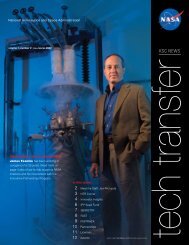2006-2007 - Kennedy Space Center Technology Transfer Office
2006-2007 - Kennedy Space Center Technology Transfer Office
2006-2007 - Kennedy Space Center Technology Transfer Office
- No tags were found...
Create successful ePaper yourself
Turn your PDF publications into a flip-book with our unique Google optimized e-Paper software.
Appendix BInnovative Partnership Program<strong>Kennedy</strong> <strong>Space</strong> <strong>Center</strong> (KSC) is NASA’s lead center for developing technologies in support of launch/landing and vehicle/payload processing. NASA’s Innovative Partnership Program (IPP) was established toprovide leveraged technologies for NASA’s mission directorates, programs, and projects through investmentsand technology partnerships with industry, academia, Government agencies, and national laboratories.Within the <strong>Technology</strong> Programs and Partnerships Branch of KSC’s Applied <strong>Technology</strong> Directorate’s, theIPP <strong>Office</strong> performs the following key program functions.Intellectual-Property ManagementHome to world-class researchers, KSC offers a number of inventions and discoveries to the outsideworld through our <strong>Technology</strong> Programs and Partnerships Branch. When discoveries or inventionsare conceived at KSC, the inventors promptly report them as innovative technologies to the<strong>Technology</strong> Programs and Partnerships Branch in order to protect the Government’s interest and toobtain the widest practicable and appropriate dissemination for the benefit of the general public andthe scientific, industrial, and commercial communities. In FY <strong>2006</strong>, 136 innovations were reportedto the <strong>Technology</strong> Programs and Partnerships Branch by KSC innovators. There were 2 patentlicenses and 10 partnerships. In FY <strong>2007</strong>, 141 new technologies were reported, together with12 partnerships and 1 patent license.<strong>Technology</strong> CommercializationLiquid Galvanic CoatingKSC developed a sacrificial coating for application to the outer surface of reinforced concrete toprotect the embedded rebar from corrosion. The coating contains one of several types of metallicparticles—magnesium, zinc, and indium. An electrical current that is established between metallicparticles in the applied coating and the surface of the steel rebar produces cathodic protection of therebar. The current forces a flow of electrons from the coating (anode) to the rebar along a separatemetallic connection; this surplus of electrons at the rebar (cathode) prevents the loss of metal ionsthat would normally occur as part of the natural corrosion process. The technology is innovativebecause it can be applied (1) to the outside surface of reinforced concrete (most rebar corrosion preventionmust be applied directly to the rebar) and (2) with a conventional brush or sprayer.The high salinity of the Atlantic and the prevalent high temperatures and humidity at <strong>Kennedy</strong><strong>Space</strong> <strong>Center</strong> accelerate the corrosion of the steel inside reinforced concrete structures, reducing theirlife. Liquid galvanic coating has been deployed successfully at the KSC to increase the life of concretestructures and reduce their associated maintenance costs.NASA applied for a U.S. patent on the Liquid Galvanic Coating System®, and the <strong>Technology</strong>Programs and Partnerships Branch marketed the technology to the corrosion prevention industry.Several companies expressed interest in commercializing the technology, including Surtreat Holdings,LLC, headquartered in Pittsburgh, Pennsylvania. Surtreat provides full-service, innovative, technicalsolutions for restoring corroded materials and preventing deterioration and corrosion in steelreinforcedconcrete structures.KSC Innovative Partnership Program129













